Alfred Willis Clemes (1887-1970)

left: Alfred Willis Clemes c. 1894 (Courtesy Tasmanian Archive and Heritage Office); right: Alfred Willis Clemes (1887-1971)
Clemes was the son of the Quaker Samuel Clemes (1845–1922), a Cornishman who went to Tasmania to establish a Quaker school in Hobart and become its first headmaster.
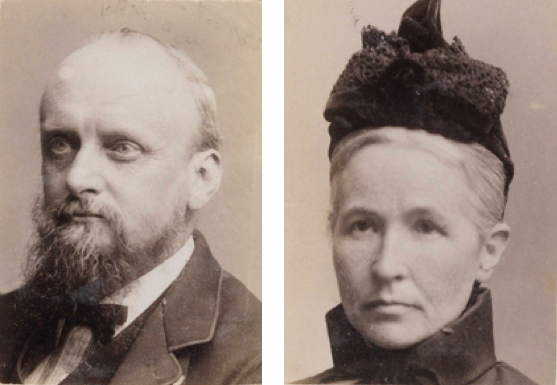
left: Samuel Clemes (1845-1922); right: Margaret Clemes (neé Hall) (1848-1923)
c. 1894 (Courtesy Tasmanian Archive and Heritage Office)
Alfred Willis Clemes matriculated as a Rhodes Scholar at Magdalen in October 1908 and graduated with a 1st class honours degree in Natural Sciences in 1910. He was also a distinguished athlete, among other things coming first in the mile in the Australian championships in 1908; winning the cross country race against Cambridge over the old Roehampton course in 1910 (with John Fortescue Worsley of Magdalen, killed in action in November 1917, coming second); and captaining Oxford in the first Australian Rules football match against Cambridge in 1911, which Oxford won. In a letter home he wrote “it is glorious up here; the life grows on it. It seems strange at first, but gets better and better every day. One meets such a lot of jolly nice fellows, and I was particularly lucky getting into Magdalen, which is far and away the best college.”
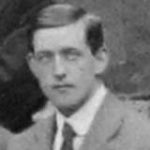
Alfred Willis Clemes, from Magdalen Group Photograph 1911
(Photo Courtesy of Magdalen College)
After leaving Magdalen Clemes became a mining engineer in Arizona (1912–14) and then at Murry’s Reward Mine, Balfour, Tasmania (1914–15). But he returned to England, joined the Friends’ Ambulance Unit (FAU) on 20 July 1915, and spent a month at the Oxhey Grange training camp before being posted as an orderly in France on 14 August 1915.

Part of the FAU Training Camp group photograph, Oxhey Grange, Hertfordshire, in August 1915
(Photograph © The Religious Society of Friends (Quakers) in Britain)
He was first posted to Ambulance Train 16, donated by the United Kingdom Flour Millers, and remained with that train until February 1916, being promoted to Corporal in September 1915.
Battle casualties were initially treated at the unit first aid post close behind the front line, run by the unit medical officer. From there they were moved (or walked if they were able) to a Field Ambulance with its Advanced Dressing Station run by the Royal Army Medical Corps (RAMC). Here those with minor wounds were patched up and even returned to the front line. More serious cases were moved several miles to the rear to a Casualty Clearing Station, where those not fit to be moved on were treated, and others were moved to base hospitals by ambulance trains.
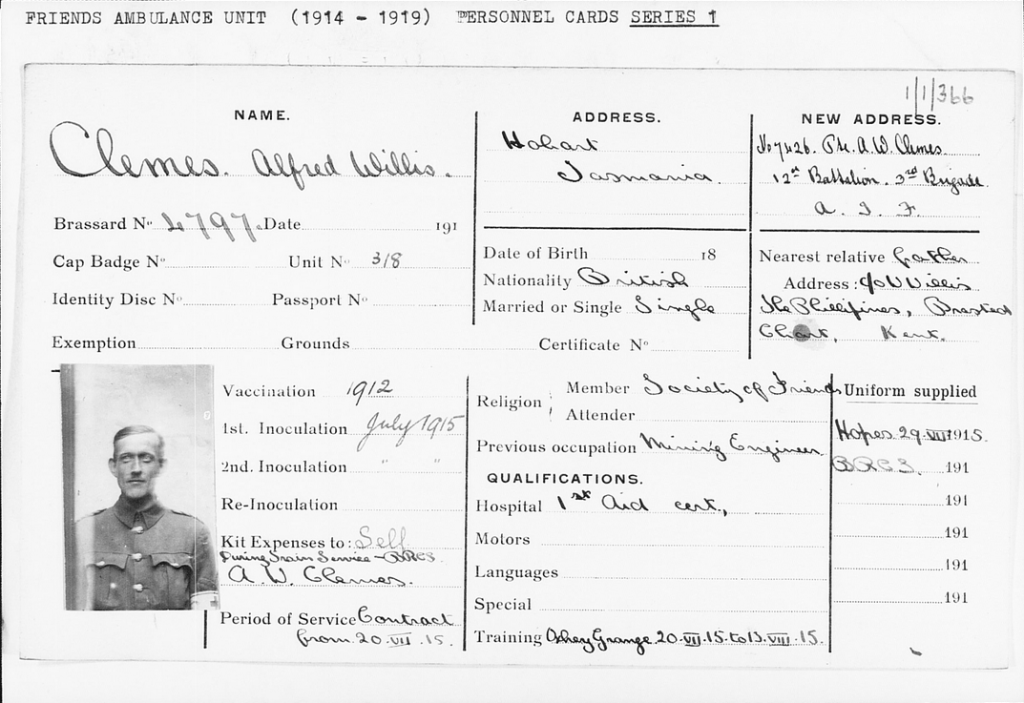
Alfred Willis Clemes, FAU Personnel Card (series 1)
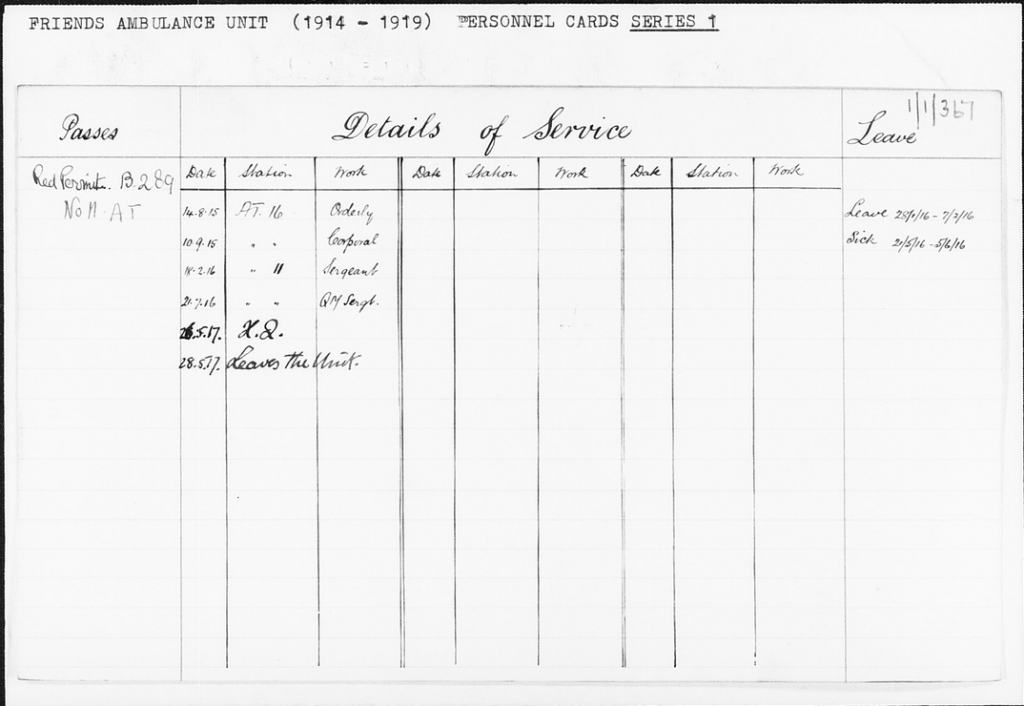
Alfred Willis Clemes, FAU Personnel Card (series 1)
On 18 February 1916 Clemes was promoted to Sergeant and transferred to Ambulance Train 11, where he was promoted to Quartermaster Sergeant on 21 July and remained with the unit until he left to join the army on 28 May 1917.

Staff of Ambulance Train 11; Clemes seated 2nd row, fourth from left.
On 30 May 1917 Clemes enlisted in the Australian Imperial Force (AIF) in London and was posted to the 12th Battalion. This was appropriate, since when first formed half the battalion was recruited from Tasmania.
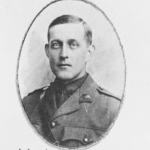
NS669-96-1-20
(Courtesy of Tasmanian Archive and Heritage Office)
The 12th Battalion was one of the first ashore in Gallipoli on 25 April 1915 and was evacuated to Egypt in December 1915. From there it was posted to France in March 1916 and was involved in the battle for Pozières in July 1916 and the Battle of Menin Road in September 1917. On 22 January 1918 Second Lieutenant Clemes joined the 12th Battalion at Wulverghem, some six miles south of Ypres, from the Training Battalion. The next day the Battalion relieved the 8th Battalion in the front line and remained there until relieved by the 30th Battalion on 31 January. The War Diary states that it was a very quiet period with no casualties and no cases of trench foot.[1]

Group portrait of officers of the 12th Battalion (E01785 Australian War Memorial); Clemes is the officer standing on the extreme right in the middle row. The photograph was taken on 28 February 1918 and by the end of the war 25% of these men had been killed.
The Battalion spent February 1918 in training at Shankill Camp, Neuve Église (Nieukerke), around four miles east of Bailleul in France, close to the Belgian border. At the end of the month the Battalion War Diary records “the best [camp] we have been in in France”. During this time Clemes and 2nd Platoon, A Company, successively won the Battalion, Brigade and Division Army Rifle Association rifle shooting competition. The Battalion was in the front line on the Ypres–Comines Canal for most of March, where one officer and 14 other ranks (ORs) were killed. They were relieved on 3 April. Clemes was promoted Lieutenant on 1 April and on 16 April the Battalion moved into the front line at Paradelles in the Ypres salient, and as they were being relieved on 23 April Clemes was wounded. Three months later on 24 July he returned to his Battalion when it was in the front line at Hazebrouck. Clemes was evacuated (wounded) on 27 July. Although there is no mention of this in the War Diary it is mentioned in the Seniority Roll of the Battalion dated 30 July 1918. When Clemes was wounded for the second time, the front occupied by the 12th Battalion was active, being raided by the Germans and sending out fighting patrols of their own. The Seniority Roll of the Battalion dated 30 December 1918 still notes Clemes as being “evacuated wounded”, but his name does not appear on the roll dated 27 February 1919. His departure is not mentioned in the War Diary.
His personal record states that he was transferred to the Education Service on 13 December 1918, and when his appointment in the Australian Imperial Force was terminated on 20 August 1919 he was still in the Education Service. He had been in the army a little over two years. The AIF Education Service was set up in December 1918, with George Long (1874–1930), Bishop of Bathurst, as Director and Captain Harry Thomson, MC (1888–1933), a well-known South Australian Rhodes scholar, as Deputy Director. “The one chief aim of this organisation is to help each individual soldier in mind, character, and occupation, and by doing so to help the future of Australia after the war.”[2] Courses were offered in Agriculture, Industrial and Technical Education, Business and Commercial Education and Preparation for University. With a South Australian Rhodes Scholar, who was his contemporary, as Deputy Director and with his experience as a mining engineer it is easy to see why Clemes was recruited to the AIF Education Service even if he was fit enough to return to his unit, where his talents may have been wasted after the armistice.
In June 1920 Clemes married, at St Mary’s, Idle Hill, Kent, Mollie Bramall (1894–1970), the daughter of the Chief Clerk to the Supreme Court of Tasmania. This was not a Quaker wedding. The bride was given away by the then Commanding Officer of the 12th Battalion, Lieutenant Colonel John Lawrence L. Whitham (1881–1952).[3] They had two children. The family settled in England and Clemes joined Platinotype Co, a business exploiting photographic processes developed by his uncle. But because of death duties and a cheaper process (e.g. Kodak) the business did not prosper. Clemes later became involved in the travel business. In 1939 Clemes was elected to the committee of the Limpsfield and Titley Conservative Association and in 1959 he retired to live in Bath. His death was registered in Chippenham in June 1970.
His career during the war poses an interesting question: Was Pearce right to include Clemes in his Register of WW1 British Conscientious Objectors? As a Quaker it seems reasonable that Clemes joined the FAU in 1915, but why did he quit some two years later to join the Australian Army? Since there was no conscription in Australia during the war (the issue having been defeated in two referendums) he was not legally bound to join the army. So, was he a pacifist? His half-brother, William Hall Clemes (1877–1953) was not. He was gazetted Lieutenant in the Australian Army in 1911,[4] although there is no evidence that he served with the AIF. Apart from being a founding member of the Royal Society of Australia, he was from 1922 to 1945 Principal of Clemes College, Hobart. A possible explanation for Alfred Clemes’s career is that he changed his views after his experience on the Ambulance Train. He was married in the Church of England, but this does not mean that he relinquished his Quaker beliefs; it may have been the wish of his wife. Stronger evidence of a change of views is that in the Magdalen College Record of 1922[5] and again of 1967. Clemes claims to have been a “Lieut. in 12th Batt., A.I.F., France 1915–18” (1922) and “Lieut. in 12th Battalion A.I.F., France 15–19” (1967), whereas there is ample evidence to show that from 14 August 1915 to 28 May 1917 he was serving with the FAU, which he seems to deny.
—
[1] The extracts are from the War Diary of the 12th Battalion, Australian War Memorial, Collection number AWM4.
[2] ‘A.I.F Education Service – A Splendid Scheme’, The Mail (Adelaide), no. 346 (28 December 1918), p. 10.
[3] ‘Australians Abroad’, The Australasian (Melbourne Vic.), no. 2,839 (28 August 1920), p. 443.
[4] Commonwealth of Australia Gazette, no. 82 (28 October 1911), p. 2106.
[5] The Magdalen College Record (1922), p. 43.